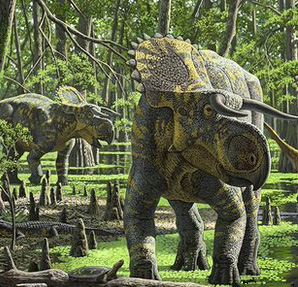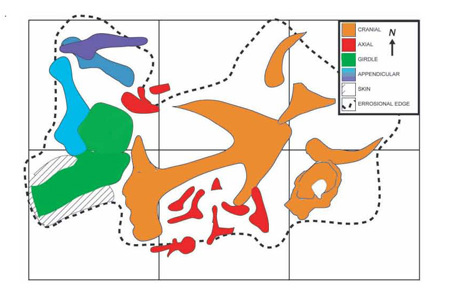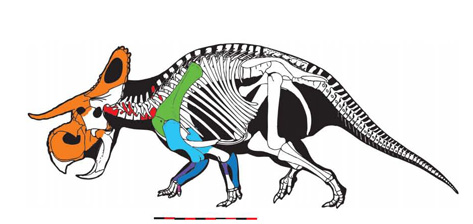“Large Nose, Horn Face” Nasutoceratops a New Dinosaur is Named
New Campanian Centrosaurine Dinosaur – Nasutoceratops titusi
A research paper detailing the work on a new type of horned dinosaur discovered in the fossil rich Kaiparowits Formation of the Grand Staircase-Escalante National Monument (southern Utah), has just been published in the academic journal Proceedings of the Royal Society B (Biology). The fossilised bones of this remarkable looking dinosaur were found back in 2006, the fossils include a nearly complete skull, plus elements from the neck and front limb bones. Although the scientists cannot be sure that this is a fully mature individual, it is still a sizeable beast, perhaps weighing as much as three tonnes and measuring nearly six metres in length.
Horned Dinosaur
An Illustration of Nasutoceratops titusi
Picture credit: Raul Martin
A Grid Diagram Showing the Layout of the Fossil Bones
Picture credit: Eric Lund et al
The picture shows the approximate layout of the fossil material in the ground, each square on the diagram represents one square metre. The skull material including the large brow horns are coloured orange, axial material (related to the neck) is in red, elements from the shoulder girdle are coloured green and front limbs blue/purple.
A Reconstruction of the N. titusi Skeleton
Picture Credit: Eric Lund et al
The diagram above shows how the fossil material found would fit into a reconstruction of the complete skeleton of this plant-eating dinosaur.
Nasutuceratops titusi
The dinosaur’s name means “large nosed horned face” after the Latin nasutus (large nosed) and the Latinised/Greek ceratops (horn face). The species name “titusi” honours Alan Titus, a palaeontologist who is renowned for his work on fossils from the Grand Staircase-Escalante National Monument.
A phylogenetic analysis of the Centrosaurinae group places Nasutoceratops as the sister taxon to Avaceratops lammersi from the Late Campanian of Montana. Nasutuceratops titusi has been designated as a basal member of the Centrosaurinae and suggests the existence of a previously unknown clade of short-snouted, long-horned centrosaurines in the southern portion of the North American landmass known as Laramidia.
Dr Mark Loewen (University of Utah and the Natural History Museum of Utah), one of the authors of the new paper published this week commented:
“This dinosaur just completely blew us away. We would never have predicted it would look like this, it is just so outside of the norm for this group of dinosaurs [centrosaurine].“
A Member of the Centrosaurinae
Centrosaurines tend to have short brow horns with the largest horn being on the snout, but this description is rapidly becoming redundant. The discovery of N. titusi with its large, curved brow horns and very broad snout challenges a lot of the assumptions palaeontologists had about the appearance of these horned dinosaurs.
When asked to comment about the large number of horned dinosaur discoveries made recently in the western United States a spokesperson from Everything Dinosaur stated:
“There have been a number of new centrosaurine and chasmosaurine dinosaurs named recently, what is perhaps more remarkable is that many of these horned dinosaur remains have been found in close proximity to the fossilised bones of other types of large, herbivorous dinosaur. For instance, the fossils of N. titusi were found in close association with hadrosaur as well as ankylosaur material. This suggests that back in the Late Cretaceous Utah was a very fertile and verdant environment capable of supporting a very diverse range of large plant-eating dinosaurs.”
Campanian Faunal Stage
The fossils have been dated as being between 75.9 and 75.2 million years old (Campanian faunal stage). A number of other types of horned dinosaur have recently been discovered in strata that make up the Grand Staircase-Escalante National Monument, including two bizarre horned dinosaurs that belong to the Chasmosaurinae. To read about this discovery: Curious Ceratopsians.
The discovery of Nasutoceratops also provides strong support for the hypothesis of regional dinosaurs in this part of the world during the Late Cretaceous. It seems that dinosaur populations became isolated in what was to become western North America and a number of independent but related populations subsequently evolved. Palaeontologists have suggested that there was a high degree of provinciality in Late Campanian mega faunas.
For articulated models of ceratopsians and other dinosaurs: Beasts of the Mesozoic Models and Figures.




